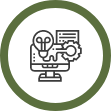
Unified Query Language (AQL)
Unlock Efficiency and Innovation: ArangoDB's Unified Query Language Simplifies Development, Reduces Costs, and Fuels Business Innovation.


Learn why G2 graph database users rank AQL higher than Cypher.

“Previously, I preferred MongoDB. However, it is one thing to write queries in JSON notation and another to use a much simpler query language to compose natural queries. Even the most complex queries in ArangoDB can be understood, built and executed by our colleagues without advanced technical skills. The whole team really appreciates AQL. It facilitates convergence in the project and creates a unique environment.”
Get started with
Graph today
(no credit card required), and experience the shortest time to value for a hosted graph DB.
Read the
Case Studies
Learn why companies across industries are switching to ArangoDB for Graph.


Simplified Development

With
ArangoDB's unified query language (AQL) simplifies development across various real-world scenarios. Consider an e-commerce platform aiming to personalize recommendations by analyzing customer behavior and product preferences. With AQL, developers can query both user profiles and purchase histories using a single language, resulting in better algorithms and faster development cycles.
Consider this: how much code is needed if a single query can simultaneously access 3 or 4 different data types and natively integrate the results? Now ask, how much code is required if separate queries need to be issued to each DB for each data type? And then, how much code to integrate the various result sets?

Without
For some competing vendors, the absence of a unified query language poses challenges in real-world scenarios. Developers may need to switch between multiple query languages, causing complexity and inefficiencies.
This can hinder rapid integration of diverse data types - like graphs, documents, and full-text search - for personalized recommendations or social network connections.
Development cycles are likely to lengthen, hindering quick deployment of innovative solutions. Higher development costs and a less streamlined development process are also likely outcomes.
Diverse Use Case Support

With
ArangoDB's unified query language enables developers to address diverse use cases seamlessly. They can work with various data models in a single query, facilitating tasks like analyzing customer behavior, fraud detection, and supply chain optimization.
ArangoDB's approach promotes efficient development, allowing developers to pivot quickly to handle new and evolving use cases, all while doing more with less. After all, if code is simpler and less error-prone, new projects can be completed faster and at a higher quality.

Without
Legacy graph databases require developers to master different query languages for various data models. This can lead to long and more complex development cycles.
It’s one thing to have developers switch between languages, which just restricts who can work on which projects and emerging use cases.
But imagine this scenario. Your use case requires real-time analytic insights from a combination of graph, document, and full text search data sources. How could this even be possible if the data has to first be integrated after being separately queried from 3 different vendor solutions? Developers should develop analytic apps, not be data integration jockeys.
Enhanced Innovation

With
Think about what’s needed to innovate if you are an analytic app developer. Mental energy for creative problem solving. The ability to rapidly prototype code for different scenarios and features. Manage a dwindling supply of hours to do the same amount of work.
ArangoDB's unified query language empowers developers with ALL of these things. No need to switch between multiple languages for different data models, freeing up time and alleviating headaches of stitching data together.
In a nutshell, AQL fosters a more efficient, focused, and innovative development process. The result? Faster iterations, quicker feature releases, and more responsive solutions to changing business needs.

Without
One of the biggest problems with multiple query languages for multiple vendor databases is that it's just too mentally taxing.
If you’re a developer, can your synapses keep firing at peak levels when you are constantly switching your mindset between languages, syntax, and optimization techniques?
Dealing with this cognitive overhead and dissonance can drain mental energy that could otherwise be directed towards creative problem-solving and innovation. Medical disclaimer: The fragmented nature of query languages could lead to frustration, unnecessary context switching, a steeper learning curve, and innovation insufficiency. Mental fatigue has occurred in most cases.
Operational Efficiency

With
If you're responsible for database ops, every minute determines the efficiency of your operations. But imagine you're constantly navigating slow data retrievals and intricate integrations, and before you know it you're losing hours per day as your frustration mounts.
Then, ArangoDB enters the scene with its unified query language. Almost instantly, your tech maintenance overhead shrinks. Data that took ages to access is now at your fingertips, and those tangled integrations become seamless workflows. ArangoDB doesn’t just enhance your developers' coding experience; it turbocharges your operational efficiency, allowing you to achieve more in less time and with fewer hitches.

Without
As legacy graph databases lack a unified query language, one of the biggest issues is all the data integration required for each and every query that spans different data types/formats.
Ask your developers how efficient it is to separately query multiple databases from different vendors and then request to have it integrated before it can be leveraged in the analytics workflow. How much time does that take? What would that time be better spent on?
Beware claims that a graph-only database can “connect” to other data sources. This doesn’t alleviate the extra step of data integration.
Get started with
Graph today
(no credit card required), and experience the shortest time to value for a hosted graph DB.
Read the
Case Studies
Learn why companies across industries are switching to ArangoDB for Graph.
